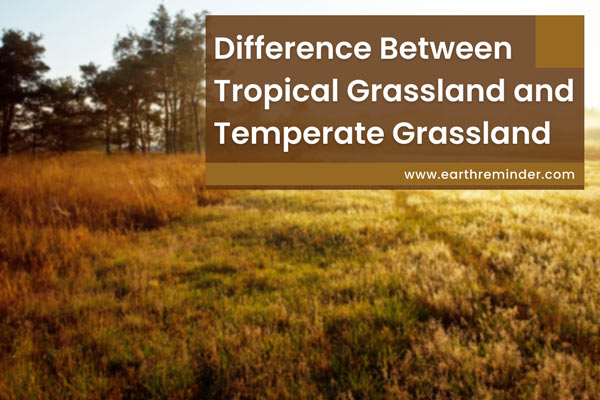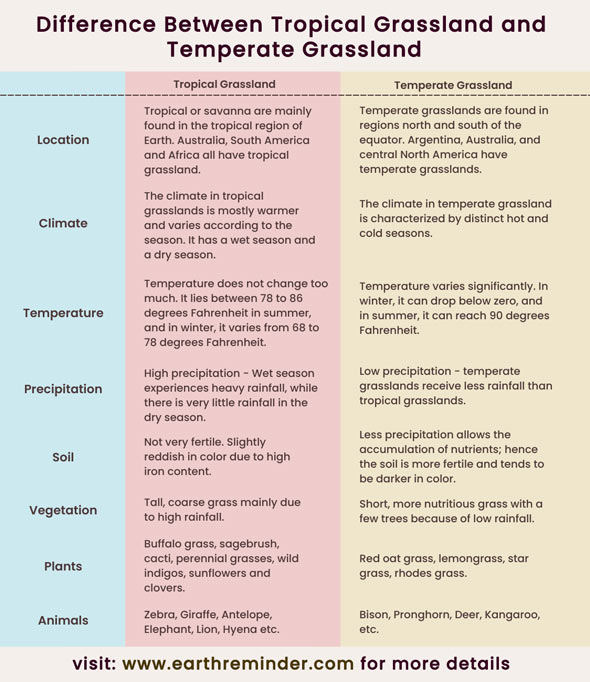Difference Between Tropical Grassland and Temperate Grassland
What Is The Difference Between Tropical Grassland and Temperate Grassland?
A grassland is a large expanse of land dominated by grasses and small shrubs. In grassland, rainfall is quite irregular and prevents larger forests from growing. Moreover, soil in grassland is too thin and is not adept at supporting larger trees.
Although grasslands across the world may look the same, they differ significantly. Mainly two types of grasslands are found on our planet – tropical grasslands and temperate grasslands.
In tropical grasslands, temperature variations are less significant, while temperate grasslands experience greater variations in temperature. This post will address the main differences between tropical grassland and temperate grassland. We will also explore different factors resulting in these differences.
Table of Contents
What are Tropical Grasslands?
The tropical grasslands, also known as savannas, are located around the tropical regions. Half of Africa and a significant part of Australia and South America are covered by savanna grassland.
These areas are characterized by vast open space, with scattered small vegetation and very few large trees.
Climate is mostly warmer, and the slight variations occur according to the season. Tropical savanna has a wet and dry season. The wet season witnesses heavy rainfall, while colder climates and less rainfall characterize the dry season.
Temperature does not vary significantly in the savanna. It lies between 25 to 30 degrees Celsius or 78 to 86 degrees Fahrenheit in summer. In winter, the temperature ranges between 20 to 25 degrees Celsius or 68 to 78 degrees Fahrenheit.
Precipitation is high; however, the rate of evaporation exceeds it, which leaves little water for the plants. Larger vegetation is very scarce, and mainly the grass and small shrubs dominate these areas. The vegetation has developed characteristics suitable for the conditions — deep roots, thick bark, and leaves that fall naturally during the winter months to conserve water. Red oat grass, lemongrass, star grass, Rhodes grass, and some shrubs are the main plants in a tropical grassland.
What is a Temperate Grassland?
Like tropical savannas, temperate grasslands are also open areas of grassy plains, mostly devoid of large trees. Depending upon the place they are located, temperate grasslands have many names. The temperate grasslands in Eurasia are called steppes, in North American prairies, and in Argentine, they are known as pampas.
Unlike tropical savannas, temperate grasslands are located in the colder regions with less rainfall. Similarly, there are greater variations in temperature. The temperature drops below zero degrees in winter, while it can soar to 90 degrees Fahrenheit in summer.
Precipitation in temperate grassland is also significantly lower than in tropical savannas. Rainfall is scarce and varies between 20 to 35 cm annually. Besides, temperate grasslands located up in the northern hemisphere experience precipitation in the form of snowfall.
Low precipitation does not allow vegetation to grow extensively. The grass that grows here has adapted to low temperatures, harsh climatic conditions, and frequent fires. They have developed deep roots that hold the grass firmly, prevent soil erosion and conserve water.
The vegetation includes buffalo grass, sagebrush, cacti, perennial grasses, wild indigos, sunflowers, and clovers.
Difference Between Tropical Grassland and Temperate Grassland
| Basis | Tropical Grassland | Temperate Grassland |
| Location | Tropical or savanna are mainly found in the tropical region of Earth. Australia, South America and Africa all have tropical grassland. | Temperate grasslands are found in regions north and south of the equator. Argentina, Australia, and central North America have temperate grasslands. |
| Climate | The climate in tropical grasslands is mostly warmer and varies according to the season. It has a wet season and a dry season. | The climate in temperate grassland is characterized by distinct hot and cold seasons. |
| Temperature | Temperature does not change too much. It lies between 78 to 86 degrees Fahrenheit in summer, and in winter, it varies from 68 to 78 degrees Fahrenheit. | Temperature varies significantly. In winter, it can drop below zero, and in summer, it can reach 90 degrees Fahrenheit. |
| Precipitation | High precipitation – Wet season experiences heavy rainfall, while there is very little rainfall in the dry season. | Low precipitation – temperate grasslands receive less rainfall than tropical grasslands. |
| Soil | Not very fertile. Slightly reddish in color due to high iron content. | Less precipitation allows the accumulation of nutrients; hence the soil is more fertile and tends to be darker in color. |
| Vegetation | Tall, coarse grass mainly due to high rainfall. | Short, more nutritious grass with a few trees because of low rainfall. |
| Plants | Buffalo grass, sagebrush, cacti, perennial grasses, wild indigos, sunflowers and clovers. | Red oat grass, lemongrass, star grass, Rhodes grass. |
| Animals | Zebra, Giraffe, Antelope, Elephant, Lion, Hyena etc. | Bison, Pronghorn, Deer, Kangaroo, etc. |
Tropical Grassland vs Temperate Grassland
The most distinguishing characteristic of tropical and temperate grasslands is the difference in temperature and precipitation.
The tropical grasslands, located mainly in Africa, South America, Australia, and Indonesia, are subjected to extreme heat throughout the year. The rainy season lasts about six to eight months, and the rainfall varies between 60 to 130 cm. The rest of the year is characterized by drought. Even though the tropical grassland receives heavy rain, the ground here is thin and only supports a few herbaceous and floral plants.
Temperate grasslands are located in regions across the north and south of the equator, including Argentina, central North America, and Australia.
Moreover, temperate grassland experiences greater temperature variations with a distinctly cold and hot season. In winter, the temperature could drop below zero. However, temperate grasslands receive only a little rainfall compared to their tropical counterparts.
Furthermore, temperate grasslands have typically harsher climatic conditions, and tornadoes, blizzards, and fires are pretty common.
Conclusion
Ecosystems on Earth are complex interactions that give rise to varied and diverse flora and fauna. Some areas may be covered in lush green vegetation, while others could be barren with no green cover. There are also regions that lie in between. Grasslands are neither utterly devoid of green cover nor support big bushy trees. Despite such characteristics, grasslands are home to some of the most magnificent species of plants and animals on Earth. Besides, not all grasslands are the same. They differ in temperature, climate, and precipitation. Each factor affects the grassland uniquely and allows them to develop their own characteristics.
In the above article, we have discussed the differences between tropical grassland and temperate grassland. If you like this article, please share it with your friends and family members.

